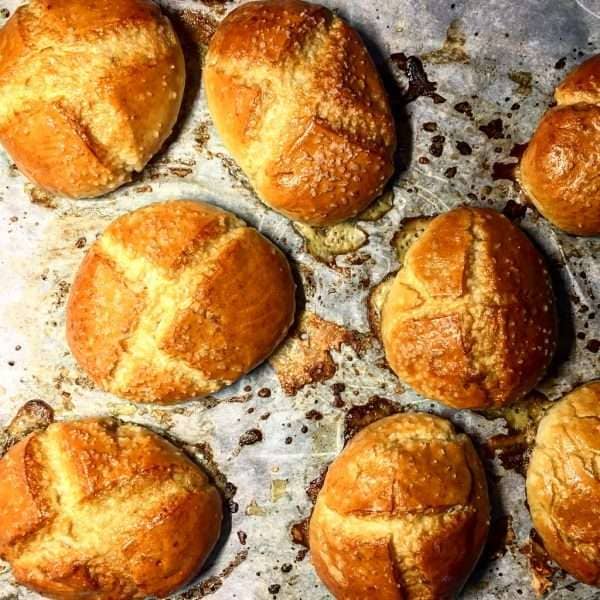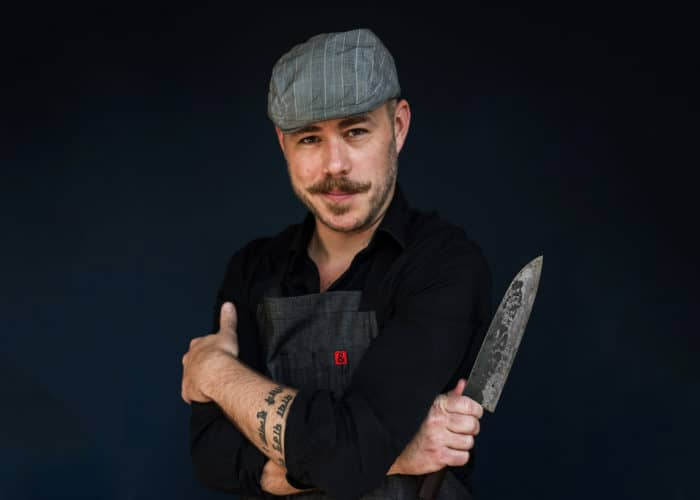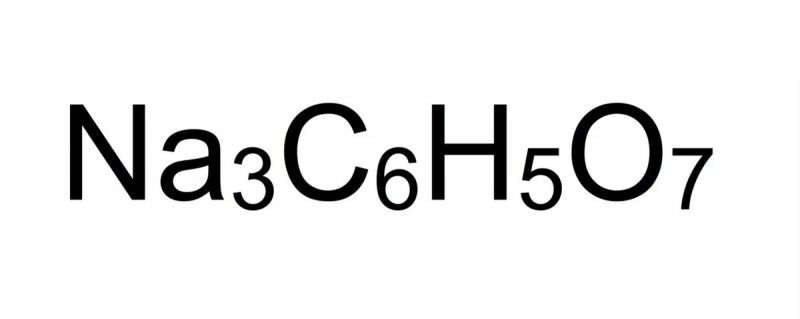Will be cooking this lovely one at some point shortly. Probably over the course of a weekend as, like all of the recipes by Mathew Ramsey, pretty much everything is made from scratch. And — as befits a former San Francisco Chronicle food writer, photographer, graphic designer and Le Cordon Bleu-trained chef — I guess that’s par.
So, the accompanying — Woodford Reserve I think for this one — bourbon may need to be broached after it’s all done. Or I can see everything going to hell in a hand-cart very, very quickly…
[The pretzel roll recipe actually comes courtesy of the fine folks of Food Republic as Mathew didn’t cover this & as we’re all making each constituent part from ‘raw’ — we are doing that aren’t we? — I thought this was needed to round off the whole artisan vibe.]
The stack:
Layer IPA cheddar cheese sauce on top of beer-braised pork cheeks…
[I’ve covered my love for pork cheeks before. An under-rated & thus under-used, flavourful part of the pig. Just right for this dish.]
…onto 1 double-fried pickle “patty” and red cabbage slaw. Surround all of this loveliness with a pretzel roll.

The sauce:
- 120ml IPA beer
- 13 grams sodium citrate *
- 1500g sharp white cheddar, shredded
Prep:
Combine the IPA with the sodium citrate in a small heavy–bottomed saucepan and bring to a simmer. Stir the mixture until the sodium citrate dissolves, then add the shredded cheese. Continue to stir the sauce until the cheese has completely melted which should take about 2 minutes. Use an immersion blender to obtain a smooth texture. Serve hot.
*[NOTE: why sodium citrate? A quick reminder of your chemistry lessons here: tight-knit proteins in cheese that hinder smooth melting, are bonded to each other with the help of calcium ions. By adding sodium citrate & liquid to the cheese mix, the sodium substitutes itself for some of the calcium that’s assisting these proteins to bind together. Then, as you heat the cheese, proteins start to separate again from each other and thus act as emulsifiers, strengthening this emulsion by holding fat and water together. The result? A smooth, stable, no leak, no lumps, melt.]
The cheeks:
- 120g plain flour
- 5g salt flakes, plus more for seasoning
- 5g black pepper, plus more for seasoning
- 900 g pork cheek
- 30ml extra–virgin olive oil
- 1/2 red onion, quartered
- 2 stalks celery, roughly chopped
- 3 cloves garlic, smashed
- 4 guajillo chiles
- 500ml pork stock
- 330ml can of IPA beer
- 5g juniper berries
- 5g black peppercorns
- 1/2 orange, quartered
- 1 bay leaf
- 8 sprigs coriander
- 6 sprigs thyme
Prep:
- Preheat the oven to 150˚C.
- Combine the flour, salt, and black pepper in a small bowl. Remove any remaining silver skin from each of the cheeks, and lightly dredge the cheeks in the flour mixture.
- Preheat a large cast-iron or heavy–bottomed pot over high heat with 1 tablespoon of the olive oil. Sear each side of the cheeks in the pot. Once browned, set aside and allow the meat to rest. You can do this in batches, if need be.
- In the same pot, heat the remaining tablespoon of olive oil over a medium heat. Add the onion and celery and sauté. Season with a pinch of salt and pepper. Once the onion begins to soften, add the garlic and chiles, stirring as needed. Continue to cook until the garlic is fragrant. Add the pork stock, beer, juniper berries, peppercorns, orange quarters, bay leaf, coriander, and thyme. You can add more beer to make sure the pork cheeks are fully submerged. Bring
everything to a boil and cover the pot with foil. Put the pot in the oven and braise until the cheeks are incredibly tender and falling apart, for up to 3 to 4 hours. - When they’re done, remove them from the liquid and allowing them to cool until you can comfortably handle the cheeks. Then shred them — using your fingers — into a bowl with a little bit of the braising broth. This should keep the meat succulent until needed.
The patty:
- 6 dill pickle spears, halved and drained on paper towels
- 360g plain flour
- 5g salt flakes, plus more for seasoning
- 5g black pepper
- 250g polenta
- 15g baking powder
- 5g ground cumin
- 3g cayenne pepper
- 1 large egg, lightly beaten
- 330 ml can of IPA-style beer
- Canola oil, for deep–frying
Prep:
- To make a pickle “patty,” skewer 3 spear halves with two toothpicks (one from the left and one from the right). To make the patty nice and compact, the two outside pickles should be facing up and the middle one facing down. Repeat until you’re out of spears.
- Drain the patties on paper towels to stop any hot oil spattering.
- In a deep fryer or a deep heavy-bottomed pan with at least 5 cm of oil, preheat your fry oil to 190˚C. (It’s important to keep the oil at this temperature or the pickles will start to turn to mush.)
- Set up a dredging station: combine ½ of the flour, the salt, and the black pepper in a small bowl. In a second bowl, combine the remaining flour and the polenta, baking powder, cumin, cayenne, egg, and beer. Whisk the batter until all of the ingredients are fully incorporated.
- Dredge the pickle patties in the flour mixture, then fully submerge in the beer batter. Carefully place the patties in the hot oil and fry until golden brown. Use tongs to move them because they’re a little fragile. Drain the patties on paper towels and allow them to cool and crisp for about a minute.
- Using the tongs again, take the fried pickle patties and once again submerge them in the beer batter and then back into the hot oil. Once fried to a golden crisp, remove them from the oil and drain on again. Allow them to cool before serving. Season with a sprinkle of salt.
The slaw:
- 15g sesame seeds
- 3g caraway seeds
- 1000g shredded red cabbage (about ½ cabbage)
- 1 jalapeño, seeded and finely chopped
- 1/2 red onion, diced
- 30g chopped fresh coriander
- 2 limes, juiced
- 30g apple cider vinegar
- 15g Sriracha sauce
- 15g extra-virgin olive oil
- 3g teaspoon sesame oil
- Salt flakes and black pepper
Prep:
- Warm a small heavy–bottomed pan over medium heat and toast the sesame and caraway seeds — shaking the pan occasionally — until the seeds darken slightly and become fragrant. Remove the seeds from the heat, because they will quickly burn.
- Then toss together everything — with salt and pepper to taste — in a large bowl. Allow the flavours to meld in the refrigerator for at least 1 hour before serving. This mix will store for up to 1 week in an airtight container in the ‘fridge.

The roll:
- 1kg flour (preferably white spelt or unbleached wheat)
- 35g fast-acting yeast
- 10g fine sea salt
- 300ml lukewarm water
- 45g unsalted butter, melted and cooled
- 45g baking soda
- coarse sea salt
Prep:
- Combine the flour, yeast and salt in a large bowl.
- In a medium bowl, whisk together the water and butter — the mixture should be lukewarm. Add to the flour mixture and mix with the dough hooks of an electric mixer for a few minutes or until well combined. If the dough is too sticky, add more flour. Transfer the dough to a work surface and continue kneading and punching it down with your hands for a few minutes until you have a smooth and elastic ball of dough. Place the dough back in the bowl, cover with a tea towel, and let rise in a warm place, or preferably in a 35°C warm oven, for 60 minutes or until doubled in size.
- When the dough has doubled in size, punch it down, take it out of the bowl, and knead for about 30 seconds. Divide the dough into 10 equal portions. Dust your hands with flour, lay a portion of dough on the palm of one hand, and with the other hand forming a dome over the dough, roll it for about 10 seconds until its top is round and firm. This process creates surface tension and prevents the buns from becoming flat. Continue with the remaining dough, then cover with a tea towel and let rise in a warm place for about 20 minutes or until puffy.
- Preheat the oven to 220ºC and line 2 baking sheets with parchment paper.
- In a large pot, wide enough to fit 2 buns at once, bring 1litre of water and the baking soda to a boil. Watch the pot; the baking soda-water mixture will foam up. With a slotted ladle or spoon, slip two buns gently into the boiling water and cook for 30 seconds, turn them over, and cook for another 30 seconds. The buns don’t need to be completely covered with the solution, but take care that they don’t stick to the bottom. Transfer the buns to the lined baking sheets, score a cross on the buns, and sprinkle with coarse sea salt.
- Cook the remaining buns in the same manner, then bake, one sheet at a time, for about 16 minutes or until golden brown.
See? That wasn’t too hard was it?
And here’s the handsome chap responsible for this

And finally? A reminder that sodium citrate’s chemical formula spells out “nacho”. No further proof of its efficacy in producing that desired smooth, gloopy cheese is needed:
